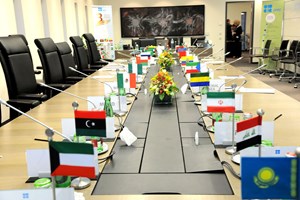OPEC with either keep cuts or ramp oil production slowly, says delegate
(Bloomberg) --The OPEC+ meeting on Thursday will discuss whether to resume a monthly schedule of modest and gradual production increases or maintain current output cuts, according to a delegate.
The choice between those two options could still go either way, the delegate said, asking not to be named because the information wasn’t public. Even if OPEC+ decided to resume phased increases, it would review each step every month, allowing it to hit pause if oil demand growth were to disappoint, the delegate said.
Many OPEC-watchers had been expecting the group to roll over its production quotas for at least one month, so any deviation from that could be bearish. Brent crude fluctuated in London, trading at $63.62 a barrel as of 1:55 p.m.
The cartel agreed in December to a monthly schedule of gradual output adjustments of as much as 500,000 barrels a day for the next three months, but after one collective supply hike in January it refrained from making any more due to doubts about the strength of demand. Now, there are growing internal and external pressures for the Organization of Petroleum Exporting Countries and its allies to pump more oil.
“We need to keep our finger on the market pulse and not allow an overheating or a significant deficit,” Russian Deputy Prime Minister Alexander Novak, whose country has been steadily increasing production this year, said at the opening session of the OPEC+ meeting. “Since we last talked, the situation has improved and the trend is positive.”
With oil prices above $60 a barrel and gasoline retail costs fast rising, consumers including the U.S. And India have started to call on the OPEC+ alliance to keep prices under control, fearful that more expensive oil could add to inflationary pressures worldwide.
Although European oil consumption is weak as France, Germany and Italy extend or impose new lockdowns due to rising Covid-19 cases, fuel use is growing fast in the U.S. where the vaccination campaign is progressing better than expected.
American refiners last week processed the most crude oil since March 2020, a sign of rising consumer demand, according to government data. Oil use in Asia remains healthy, with strong readings in China and Japan.
A spokesman for the Saudi Energy Ministry had no immediate comment. People familiar with the call said the two officials discussed collaboration between the U.S. and the kingdom around areas like hydrogen, renewables and carbon sequestration, rather than the oil market.
Within OPEC+ itself, Russia has long favored further production increases. Now, some other nations are keen to signal that supply can rise over the next few months, as demand is expected to recover during the northern-hemisphere summer.
“For most part, the market is on stable footing and stocks continue to draw down. Even in those sectors that were badly hit such as airline travel, there are signs of meaningful improvement,” Prince Abdulaziz said in his opening speech. Still, the minister said OPEC+ had been right to roll over its cuts at last month’s meeting and “until the evidence of recovery is undeniable we should maintain this cautious stance.”




